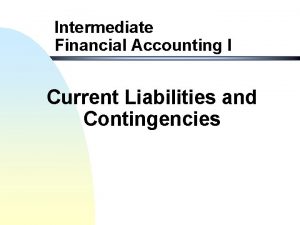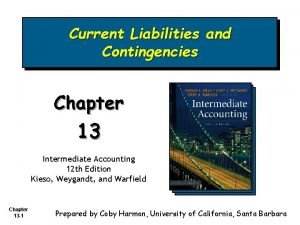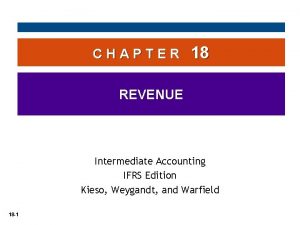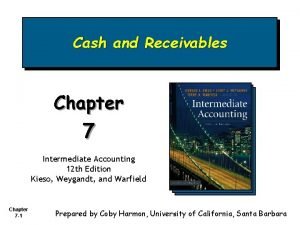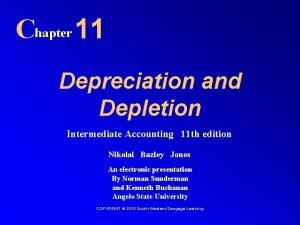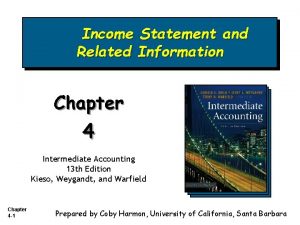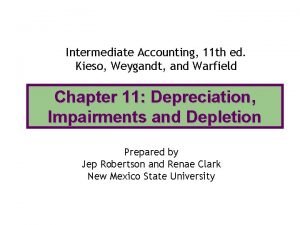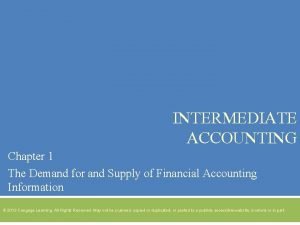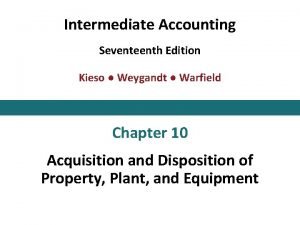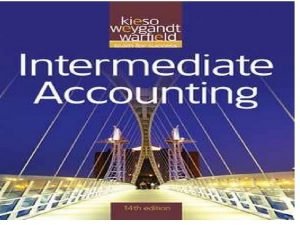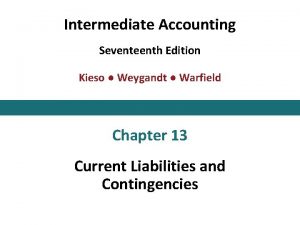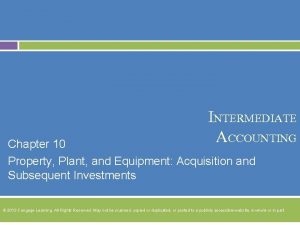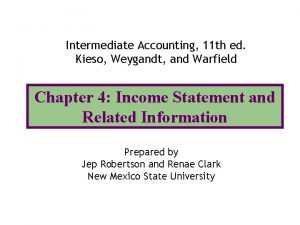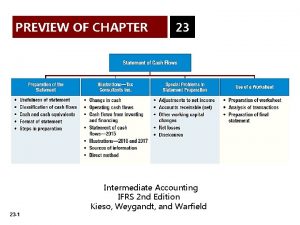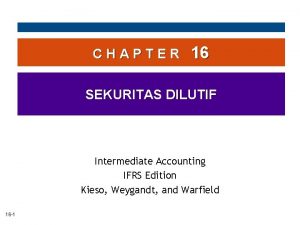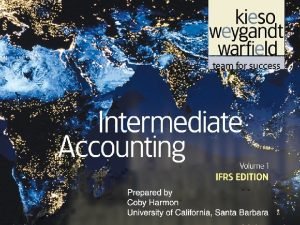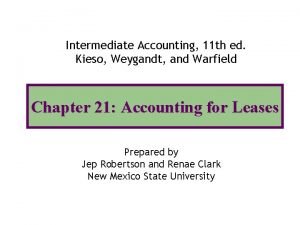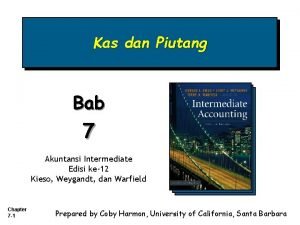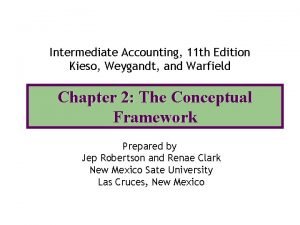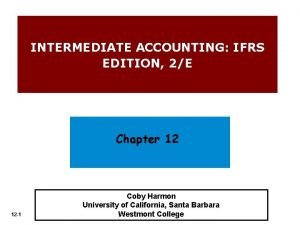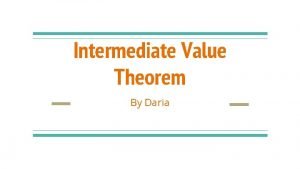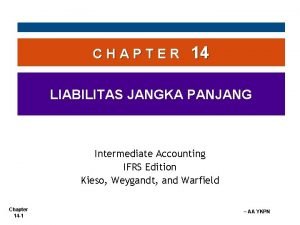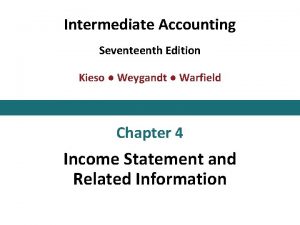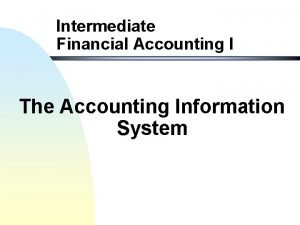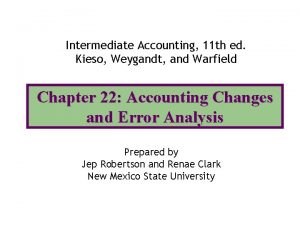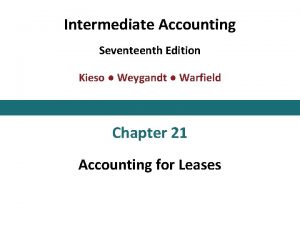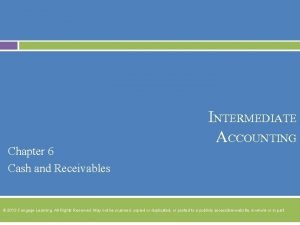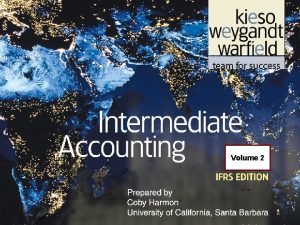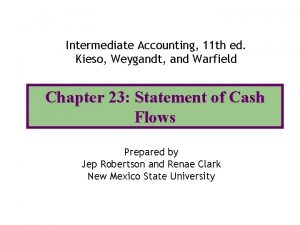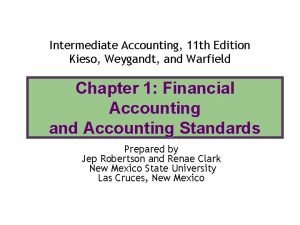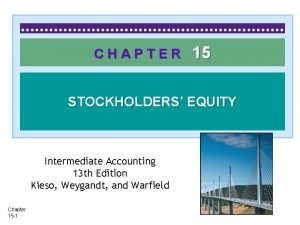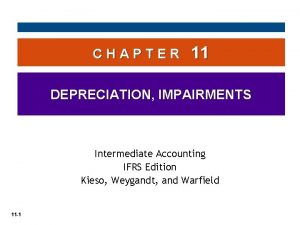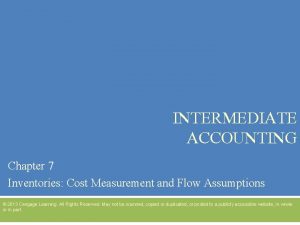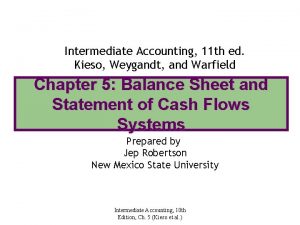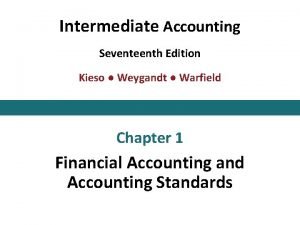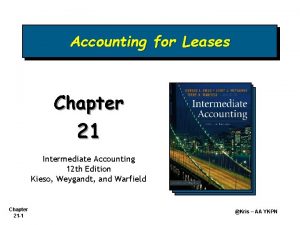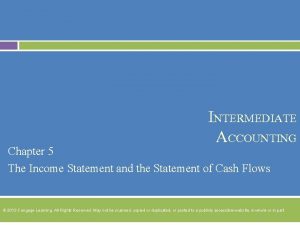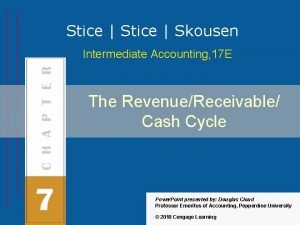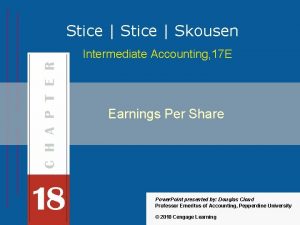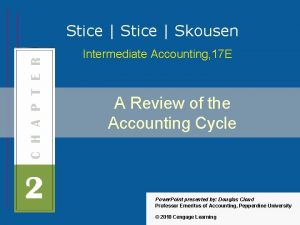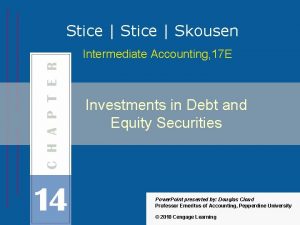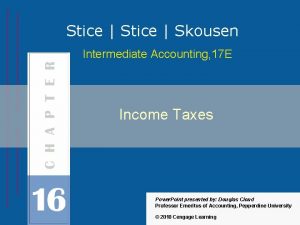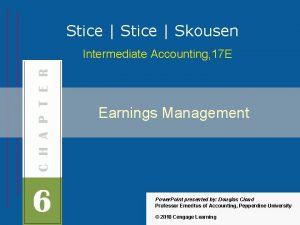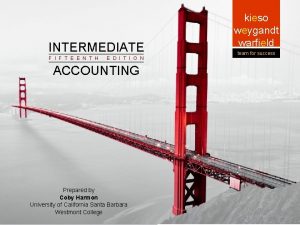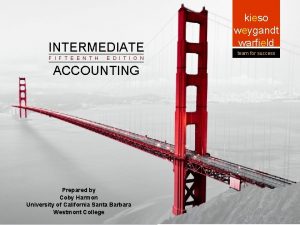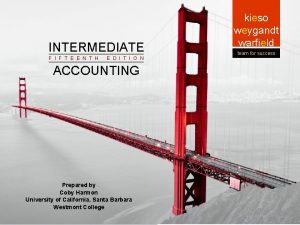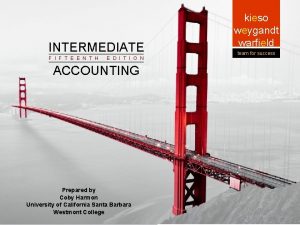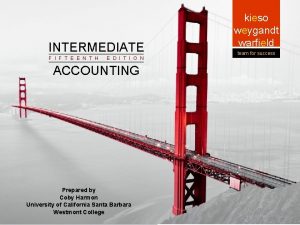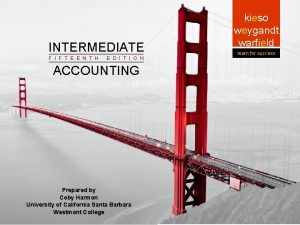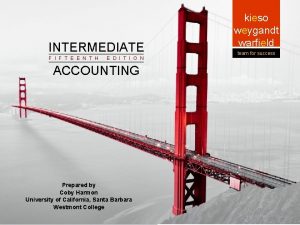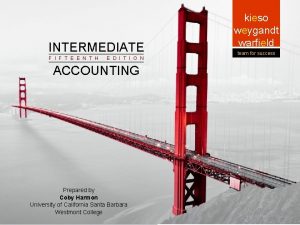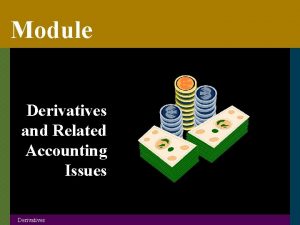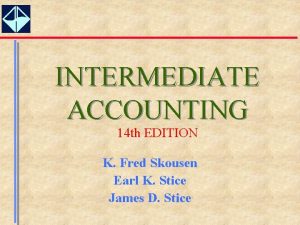Stice Skousen Intermediate Accounting 17 E Derivatives Contingencies


















































- Slides: 50

Stice | Skousen Intermediate Accounting, 17 E Derivatives, Contingencies, Business Segments, and Interim Reports Power. Point presented by: Douglas Cloud Professor Emeritus of Accounting, Pepperdine University © 2010 Cengage Learning 19 -1

Simple Example of a Derivative You are an employee of Nauvoo Software Solutions. On October 1, 2011, you purchase 100 shares of stock in the company at the market price of $50 per share, for a total price of $5, 000. (continues) 19 -2

Simple Example of a Derivative • On January 1, 2012, you need to make a college tuition payment of $5, 000 on behalf of your daughter. You can’t sell the stocks now because your employment contract states that the shares must be held for at least three months before they can be sold. How can you avoid downward movement in the stock price between now and January 1? (continues) 19 -3

Simple Example of a Derivative You can avoid downward movement if you make the following agreement: If the price of the stock is above $50 per share, you agree to pay cash equal to the excess to John Bennett, a local speculator. If the price goes below $50, Bennett will pay you a cash amount equal to the deficit. This agreement is called a derivative. (continues) 19 -4

Simple Example of a Derivative • A derivative is a financial instrument or contract that derives its value from the movement of the price, foreign exchange rate, or interest rate on some other underlying asset. • When the agreement is made, no journal entry is required, because it is merely an exchange of promises about some future action; that is, an executory contract. (continues) 19 -5

Simple Example of a Derivative How does this derivative agreement solve your risk management dilemma? Look at the following chart: No matter what happens, you will wind up with $5, 000 on January 1. 19 -6

Types of Risk • Price risk is the uncertainty about the future price of an asset. • Credit risk is the uncertainty that the party on the other side of the agreement will abide by the terms of the agreement. • Interest rate risk is the uncertainty about future interest rates. • Exchange rate risk is the uncertainty about the U. S. dollar cash flows arising when assets and liabilities are denominated in a foreign currency. 19 -7

Types of Derivatives • A swap is an agreement to exchange payments in the future, usually a fixed payment for a variable payment, or vice versa. • A forward is an agreement to exchange an item at a set date in the future at a price that is set now. (continues) 19 -8

Types of Derivatives • A future is quite similar to a forward except that the terms of futures contracts are standardized and these contracts are traded in markets. • An option is the right to buy or sell an asset at a specified price in the future. 19 -9

Swap • Pratt takes advantage of a good working relationship with a bank, receiving a 2 -year, $100, 000 loan with interest payments occurring at the end of each year. • The interest rate for the first year is 10%, and the rate in the second year will be equal to the market interest on January 1 of that year. (continues) 19 -10

Swap • Pratt enters into an interest rate swap agreement with another party whereby Pratt agrees to pay a fixed interest rate of 10% on the $100, 000 loan to that party in exchange for receiving a variable amount based on the prevailing market rate. • Pratt will receive an amount equal to [$100, 000 × (Jan. 1, 2012 interest rate – 10%)] if the interest rate is above 10%. (continues) 19 -11

Swap To see the impact of this interest rate swap, consider the following table: Pratt will pay $10, 000 no matter what the prevailing interest rate. 19 -12

Forwards • On November 1, 2011, Clayton Company sold machine parts to Maruta Company for ¥ 30, 000 to be received on January 1, 2012. • The current exchange rate is ¥ 120 = $1. • Clayton enters into a forward contract with a large bank that guarantees this exchange rate. (continues) 19 -13

Forwards The impact of the forward exchange is shown in the following table: The prevailing exchange rate is called the spot rate. 19 -14

Futures • Hyrum Bakery uses 1, 000 bushels of wheat every month. On December 1, 2011, Hyrum decides to protect itself against price movements. Hyrum buys a futures contract to purchase 1, 000 bushels of wheat on January 1, 2012, at $4 per bushel. • As with other derivatives, a wheat futures contract is usually settled by a cash payment at the end of the contract. (continues) 19 -15

Futures The effect of the futures contract is illustrated in the following table: 19 -16

Option • A call option gives the owner the right to buy an asset at a specified price. • A put option gives the owner the right to sell an asset at a specified price. • The owner of the option pays an amount in advance to the party on the other side of the transaction, who is called the writer of the option. 19 -17

Option On October 1, 2011, Woodruff Company decides that it will need to purchase 1, 000 ounces of gold for use in its computer chip manufacturing process in January, 2012. Gold is selling for $300 per ounce on October 1, 2011. Woodruff enters into a call option contract on October 1 which gives Woodruff the right, but not the obligation, to purchase 1, 000 ounces of gold at a price of $300 per ounce. (continues) 19 -18

Option The option period extends to January 1, 2012, and Woodruff has to pay $8, 000 to buy this option. In exchange for this payment, the option arrangement protects Woodruff from unfavorable movements in the price of gold but also allows Woodruff to benefit from favorable movements. This can be seen in the table displayed on Slide 19 -20. (continues) 19 -19

Option The option contract means that Woodruff will pay no more than $300 per ounce for the gold. 19 -20

Types of Hedging Activities • Broadly defined, hedging is the structuring of transactions to reduce risk. • A fair value hedge is a derivative that offsets, at least partially, the change in the fair value of an asset or a liability. • A cash flow hedge is a derivative that offsets, at least partially, the variability in cash flows from forecasted transactions that are probable. 19 -21

Overview of Accounting for Derivatives and Hedging Activities 1. Balance sheet. Derivatives should be reported in the balance sheet at their fair value as of the balance sheet date. 2. Income statement. When a derivative is used to hedge risks, the gains and losses on the derivative should be reported in the same income statement in which the income effects on the hedged items are reported. 19 -22

Overview of Accounting for Derivatives and Hedging Activities • No hedge. All changes in the fair value of derivatives that are not designated as hedges are recognized as gains or losses in the income statement in the period in which the value changed. • Fair value hedge. Changes in the fair value of derivatives designated as fair value hedges are recognized as gains or losses in the period of the value change. (continues) 19 -23

Overview of Accounting for Derivatives and Hedging Activities • Cash flow hedge. Changes in the fair value of derivatives designated as cash flow hedges are recognized as part of the Accumulated Other Comprehensive Income account. To account for a derivative as a hedge, a company must define, in advance, how it will determine whether the derivative is functioning as an effective hedge. 19 -24

Overview of Accounting for Derivatives and Hedging Activities • Companies must provide a description of their risk management strategy and how derivatives fit into that strategy. • Firms must disclose the gains and losses on derivatives, separated by category: § Fair value hedges § Cash flow hedges § Other (continues) 19 -25

Overview of Accounting for Derivatives and Hedging Activities • The notional amount is the total face amount of the asset or liability that underlies a derivative contract. • Notional amounts frequently grossly overstate both the fair value and the potential cash flows of derivatives. 19 -26

Illustrations of Accounting for Derivatives and Hedging Activities On January 1, 2011, Pratt Company received a twoyear $100, 000 variable-rate loan and also entered into an interest rate swap agreement. 2011 Jan. 1 Cash Loan Payable 100, 000 No entry is made to record the swap agreement because the swap has a fair value of $0. (continues) 19 -27

Illustrations of Accounting for Derivatives and Hedging Activities • The market interest rate on December 31, 2011 is 11%. • The interest rate swap asset is reported at its present value of $901 ($1, 000 discounted) in the December 31, 2011 balance sheet. (continues) 19 -28

Illustrations of Accounting for Derivatives and Hedging Activities The journal entry to record Pratt’s 2011 interest payment, along with the adjusting entry, is: 2011 Dec 31 Interest Expense Cash ($100, 000 × 0. 10) 10, 000 Interest Rate Swap (asset) Other Comprehensive Income 901 (continues) 10, 000 901 19 -29

Illustrations of Accounting for Derivatives and Hedging Activities 2012 Dec 31 Interest Expense Cash ($100, 000 × 0. 11) 11, 000 Cash (from swap agreement) 1, 000 Interest Rate Swap (asset) Other Comprehensive Income ($901 × 0. 11) Accumulated Other Comprehensive Income 1, 000 Interest Expense Loan Payable 100, 000 Cash (continues) 11, 000 901 99 1, 000 100, 000 19 -30

Illustrations of Accounting for Derivatives and Hedging Activities On November 1, 2011, Clayton Company sold machine parts to Maruta Company for ¥ 30, 000 to be received on January 1, 2012. On the same date, Clayton also entered into a yen forward contract. 2011 Nov. 1 Yen Receivable Sales 250, 000 ¥ 30, 000 ÷ ¥ 120 per $1 (continues) 19 -31

Illustrations of Accounting for Derivatives and Hedging Activities The impact of the change in the yen exchange rate on both the yen receivable and the value of the forward contract is accounted for as follows: (continues) 19 -32

Illustrations of Accounting for Derivatives and Hedging Activities The actual exchange rate on December 31, 2011 is ¥ 119 = $1. Clayton will have a loss on the forward contract and will be required to make a $2, 101 payment [(¥ 30, 000/¥ 119 per $1) – $250, 000]. 2011 Dec. 31 Loss on Forward Contract Yen Receivable Gain on Foreign Currency (continues) 2, 101 19 -33

Illustrations of Accounting for Derivatives and Hedging Activities The journal entries necessary in Clayton’s books on January 1, 2012, to record receipt of the yen payment and settlement of the yen forward contract area as follows: 2012 Jan. 1 Cash (¥ 30, 000/¥ 119 per $1) Yen Receivable Forward Contracts (liability) Cash (forward contract settlement) (continues) 252, 101 19 -34

Illustrations of Accounting for Derivatives and Hedging Activities • It should be noted that the Clayton forward contract does not qualify for hedge accounting under FASB Statement No. 133. • Derivatives that serve as economic hedges of foreign currency assets and liabilities are accounted for as speculations, with all gains and losses recognized as part of income immediately. (continues) 19 -35

Illustrations of Accounting for Derivatives and Hedging Activities • On December 1, 2011, Hyrum Company decided to hedge against potential fluctuations in the price of wheat for its forecasted January 2012 purchases. • The firm bought a futures contract entitling and obligating Hyrum to purchase 1, 000 bushels of wheat on January 1, 2012, for $4 per bushel. (continues) 19 -36

Illustrations of Accounting for Derivatives and Hedging Activities • No entry is made to record the futures contract. • The actual price of wheat on December 31, 2011, is $4. 40 per bushel. Hyrum will receive a $400 payment [1, 000 bushels × ($4. 40 – $4. 00)] on January 1, 2012, to settle the futures contract. (continues) 19 -37

Illustrations of Accounting for Derivatives and Hedging Activities The impact of the change on the anticipated cost of wheat when purchased in January 2012 is accounted for as follows: (continues) 19 -38

Illustrations of Accounting for Derivatives and Hedging Activities The adjusting entry to recognize the change in the fair value of the futures contract is as follows: 2011 Dec. 31 Wheat Futures Contract (asset) 400 Other Comprehensive Income 400 The gain from the increase in the value of Hyrum’s futures contract is deferred as a part of other comprehensive income. (continues) 19 -39

Illustrations of Accounting for Derivatives and Hedging Activities The entries to record the purchase of 1, 000 bushels of wheat in the open market and the cash settlement of the wheat future contracts are as follows: 2012 Jan. 1 Wheat Inventory 4, 400 Cash (1, 000 bushels × $4. 40) 4, 400 Cash (futures contract settlement) 400 Wheat Futures Contract (asset) 400 Accumulated Other Comprehensive Income 400 Gain on Futures Contract 400 19 -40

Accounting for Contingencies • Contingent losses. Circumstances involving potential losses that will not be resolved until some future event occurs. • Contingent gains. Circumstances involving potential gains that will not be resolved until some future event occurs. 19 -41

Accounting for Lawsuits FASB Statement No. 5 identifies several key factors to consider. These include the following: 1. The nature of the lawsuit 2. Progress of the case in court, including progress between date of the financial statements and their issuance date 3. Views of legal counsel as to the probability of loss 4. Prior experience with similar cases 5. Management’s intended response to the lawsuit 19 -42

Accounting for Environmental Liabilities • The SEC staff issued Staff Accounting Bulletin No. 92, which set forth the SEC’s interpretation of GAAP regarding contingent liabilities, with particular applicability to companies with environmental liabilities. • The AICPA issued SOP 96 -1 outlining key events that can be used to determine whether an environmental liability is probable. (continues) 19 -43

Accounting for Environmental Liabilities • The FASB, in Statement No. 143, requires that an obligation associated with retiring an asset should be recognized when incurred and be measured using present value techniques. The offsetting debit should be an addition to the cost of the associated asset. 19 -44

Business Segments Information to be disclosed in the financial statement notes under the provisions of FASB Statement No. 14 included revenues, operating profit, and identifiable assets for each significant industry segment of a company. 19 -45

Business Segments FASB Statement No. 131 additional disclosure requirements: 1. Total segment operating profit or loss 2. Amounts of certain income statement items such as operating revenues, depreciation, interest revenue, interest expense, tax expense, and significant noncash expenses 3. Total segment assets (continues) 19 -46

Business Segments 4. Total capital expenditures 5. Reconciliation of the sum of segment totals to the company total for each of the following items: § Revenues § Operating profits § Assets (continues) 19 -47

Business Segments In addition to these five items, companies must also disclose how operating segments are identified. Revenue test. A segment should be reported if its total revenue is 10% or more of the company’s total revenue (external and internal). (continues) 19 -48

Business Segments Profit test. A segment should be reported if the absolute value of its operating profit (or loss) is greater than 10% of the total operating profit for all segments that reported profits Asset test. A segment should be reported if it contains 10% or more of the combined assets of all operating segments. 19 -49

Interim Reports • Statements showing financial position and operating results for intervals of less than a year are referred to as interim financial statements. • There are two prominent viewpoints about reporting interim results. § Each reporting interval is to be recognized as a separate accounting period. § The interim period is an integral part of the annual period (accepted by the APB in Opinion No. 28). 19 -50
 Accounting for current liabilities and contingencies
Accounting for current liabilities and contingencies Accounting for current liabilities and contingencies
Accounting for current liabilities and contingencies Net realizable value formula
Net realizable value formula Intermediate accounting chapter 18
Intermediate accounting chapter 18 Notes receivable journal entry
Notes receivable journal entry Composite depreciation rate
Composite depreciation rate Intermediate accounting chapter 4
Intermediate accounting chapter 4 Impairment in finance meaning
Impairment in finance meaning Intermediate accounting chapter 1
Intermediate accounting chapter 1 Commercial substance
Commercial substance Chapter 19 accounting for income taxes
Chapter 19 accounting for income taxes Intermediate accounting chapter 1
Intermediate accounting chapter 1 Intermediate accounting chapter 17 investments solutions
Intermediate accounting chapter 17 investments solutions Chapter 2 conceptual framework
Chapter 2 conceptual framework Revenue recognition intermediate accounting
Revenue recognition intermediate accounting Equity adalah
Equity adalah Warranty journal entries
Warranty journal entries Chapter 10 property plant and equipment
Chapter 10 property plant and equipment Intermediate accounting kieso
Intermediate accounting kieso Chapter 23 statement of cash flows
Chapter 23 statement of cash flows Intermediate accounting chapter 16
Intermediate accounting chapter 16 Chapter 3 intermediate accounting
Chapter 3 intermediate accounting Chapter 12 intermediate accounting
Chapter 12 intermediate accounting Intermediate accounting chapter 1
Intermediate accounting chapter 1 Intermediate accounting
Intermediate accounting Chapter 7 intermediate accounting
Chapter 7 intermediate accounting Primary qualities of accounting information
Primary qualities of accounting information Kunci jawaban intermediate accounting chapter 12
Kunci jawaban intermediate accounting chapter 12 Liablities
Liablities Intermediate value theorem khan academy
Intermediate value theorem khan academy Chapter 14 intermediate accounting kieso bahasa indonesia
Chapter 14 intermediate accounting kieso bahasa indonesia Intermediate accounting
Intermediate accounting Closing entries example
Closing entries example Intermediate accounting kieso
Intermediate accounting kieso Intermediate accounting
Intermediate accounting Chapter 21 intermediate accounting
Chapter 21 intermediate accounting Cash and receivables intermediate accounting
Cash and receivables intermediate accounting Chapter 15 intermediate accounting
Chapter 15 intermediate accounting Under ifrs the presumption is that equity investments are
Under ifrs the presumption is that equity investments are Intermediate accounting kieso
Intermediate accounting kieso Intermediate accounting شرح
Intermediate accounting شرح Intermediate accounting
Intermediate accounting Lessor versus lessee
Lessor versus lessee Conceptual framework of iasb and fasb
Conceptual framework of iasb and fasb Chapter 15 intermediate accounting
Chapter 15 intermediate accounting Chapter 11 intermediate accounting
Chapter 11 intermediate accounting The lifo conformity rule
The lifo conformity rule Intermediate accounting
Intermediate accounting What is gaap in accounting
What is gaap in accounting Chapter 21 accounting for leases kieso terjemahan
Chapter 21 accounting for leases kieso terjemahan Intermediate accounting chapter 5
Intermediate accounting chapter 5
